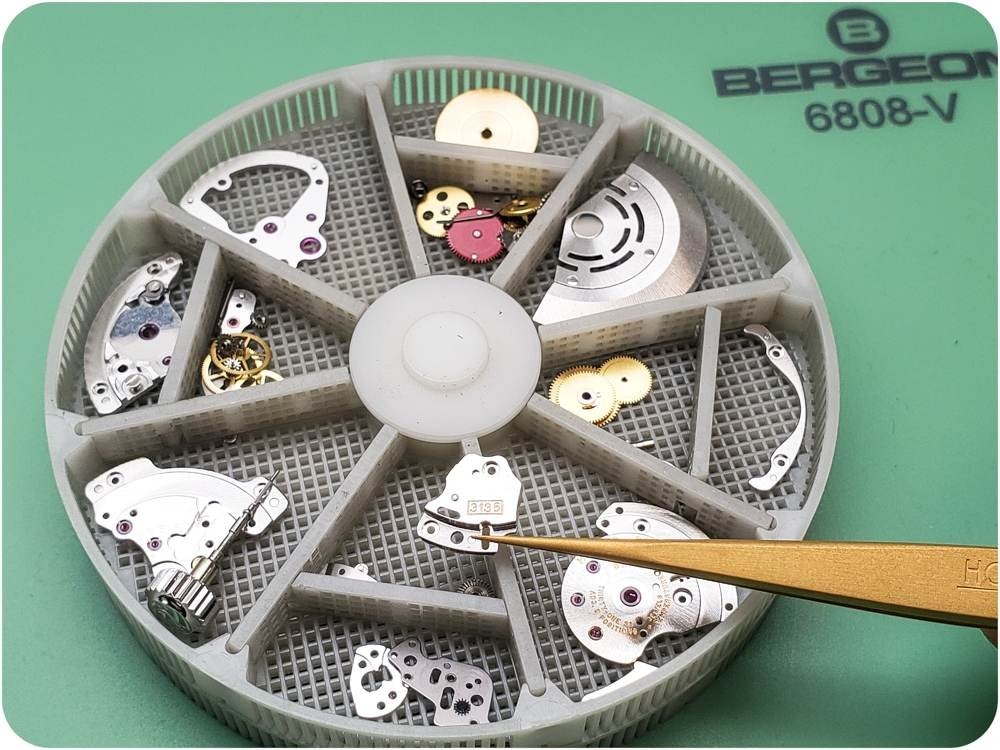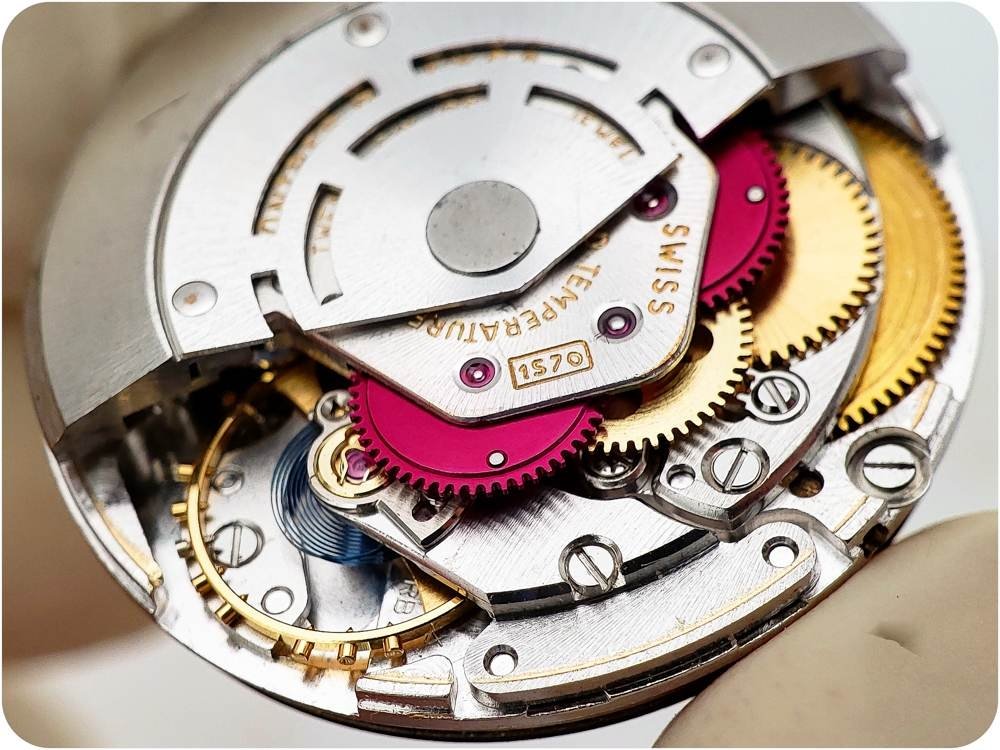It’s no secret that Rolex watches have evolved to become a status symbol. As the brand likes to remind us, Rolex is synonymous with prestige and excellence. And while there is no denying the attractive qualities of the exterior of a Rolex, these watches would have not stood the test of time without the movements that power them.

Yes, it is true that Rolex calibers are not the prettiest movements out there; they are after all hidden behind solid metal screw-down case-backs. But what they lack in decoration and finishing, they certainly make up for in robustness, durability, practicality—and serviceability.
Rolex mechanical movements were always built for an active life—whether it is diving, cave exploring, mountain climbing, jet setting, or running an empire. They were never conceived as delicately decorated calibers to stare at through a transparent case-back crystal.
Some Rolex owners claim that these movements are so tough that they never need any maintenance. Other more responsible wearers however, understand that no matter how well built a Rolex caliber is, it certainly does need regular servicing to ensure optimal performance and increased longevity.
If you have ever wondered how a Rolex watch is serviced, read our complete guide to learn more.
Rolex Movements
Before delving into how a Rolex watch is serviced, it is important to understand a little bit about the history of Rolex movements and highlighting some notable calibers and innovations along the way. Rolex has filed around 400 patents throughout its history—a clear indication that the company places a premium on technical innovations.
While Rolex has certainly made manual-wound and quartz movements, the brand is most famous for making automatic mechanical movements for its watches. In fact, it was in 1931, that Rolex invented the first self-winding mechanism with a Perpetual rotor. This patented structure not only serves as the basis of all Rolex automatic movements but also that of most self-winding watches from any brand since the invention went into the public domain in 1948. While the Rolex watch is being worn, the natural motion of a wrist causes the Perpetual rotor to swing back and forth, which then serves to automatically wind up the watch. This replaces the need to regularly wind up a watch.
Another innovation that has played a part in the success of Rolex watches is the company’s emphasis on water resistance which actually came before the Perpetual rotor mechanism. In 1926, Rolex unveiled the Oyster case built with a screw-down crown, screw-down case-back, and a bezel securing the acrylic crystal to the case. This three-part structure keeps water and dust out of the watch.
Since then, Rolex has improved the water resistance of its watches across the board with a rating of 100 meters for most of its models, 300 meters for Submariner watches, 1,220 meters for Sea-Dweller watches, and 3,900 meters for Deepsea watches.
In 2000, Rolex introduced a patented hairspring made in an exclusive alloy of niobium, zirconium, and oxygen for optimal precision. In 2005, Rolex developed a patented process to treat the surface of the hairspring to reinforce its stability, which also happens to turn the piece blue. This exclusive movement component is called the Parachrom hairspring and Rolex maintains that it is resistant to magnetism and temperature swings, and it remains up to 10 times more accurate than a traditional hairspring in case of shocks, no wonder that watches made by Rolex tend to be more accurate than other watch brands.
In 2005, Rolex also introduced the patented Paraflex shock absorb system, which improves a watch’s shock resistance by up to 50%.
How Long Does it Take to Make and Assemble a Rolex Movement?
Today, Rolex has four main manufacturing sites in Switzerland. The Rolex Bienne site is where the company’s movements are produced. All Rolex calibers are made entirely in-house now (this was not always the case) and every single one is hand-assembled. However, it is important to note that Rolex houses incredible cutting-edge machinery that manufactures the components of the movement very rapidly. For instance, Rolex produces base-plates at a rate of 100 per minute.
It is this magic formula of high-tech machinery and hands-on craftsmanship that allows Rolex to produce up to one million (estimated) topnotch timepieces a year.
Rolex famously claims that it takes a whole year to make a Rolex watch from start to finish, but lets be realistic. With the ability to produce hundreds of parts simultaneously, the entire process should not take longer than a week, unless the delay is a part of their marketing game. I’m just speculating, but in realist the wait period for a new Rolex Daytona ref. 16500 is approximately 5 years unless you are ready to pay double for what its really worth. Remember that Rolex is a highly vertically integrated manufacturing company, making the majority of all the components that go into the watch from the materials to the case to the bracelet to the movement parts in-house. So while it may just take a few hours to assemble the watch, it takes much longer to manufacture all the pieces required and to conduct all the final testing to ensure peak performance.
Notable Rolex Calibers
Rolex movements can be generally classified into six categories: time only, date, day/date, GMT, chronograph, and annual calendar.
Frequency rate indicates how many beats per hour the movement operates. Today, all Rolex calibers operate at a frequency of 28,800 beats per hour, which is equivalent to eight ticks per second. This is why the seconds hands of an automatic Rolex looks like it “sweeps” around the dial compared to the seconds hand of a quartz watch that “jumps” to the next position once every second.
Power reserve is the term used for how much power a watch can store while lying dormant before running out of juice. Depending on the caliber, Rolex watches can have anywhere from 42 hours to 70 hours of power reserve. Once an automatic watch depletes its power reserve, all it takes is some winding to get it going again and once it’s on the wrist, it will continue to self-wind again thanks to the rotor.
When a watch has “hacking” function, it means that the seconds hand comes to a complete stop when the winding crown is pulled out to the second position. This allows for precise time-setting.
A quick set date (or day) feature means that the calendar window can be set independently from the center hour and minute hands. To change the date on a non-quick-set watch means having to continuously turn the minute hand around the dial past midnight until the correct date appears in the window, that is why it is a good idea to set the date properly during the first attempt otherwise you will have to repeat the entire process over.
Now that we have covered some technical terms, here is a list of some of Rolex’s most notable calibers.
Rolex Time Only Calibers

These movements power the simple time-only Rolex watches, sometimes referred to as “three-handers.”
| Reference | Intro Year | Frequency Rate & Power Reserve | Used in which Rolex watches | Notes |
|---|---|---|---|---|
| Caliber 1570 | 1965 | – 19,800 bph – 42 hours | Oyster Perpetual, Submariner, Explorer | Hacking function added in 1972 |
| Caliber 3000 | 1990 | – 28,800 bph – 42 hours | Air-King, Submariner, Explorer | |
| Caliber 3130 | 2000 | – 28,800 bph – 48 hours | Oyster Perpetual, Air-King, Submariner, Explorer | Parachrom hairspring |
| Caliber 3131 | 2007 | – 28,800 bph – 48 hours | Milgauss, Air-King | – Anti-Magnetic Parachrom hairspring – Paraflex anti-shock system |
| Caliber 3132 | 2010 | – 28,800 bph – 48 hours | Explorer, Oyster Perpetual | – Anti-Magnetic Parachrom hairspring – Paraflex anti-shock system |
Rolex Date Calibers
These movements power the Rolex watches that have a date window at 3 o’clock. It is interesting to note that there are currently more Rolex watches with date windows than without.
| Reference | Intro Year | Frequency Rate & Power Reserve | Used in which Rolex watches | Notes |
|---|---|---|---|---|
| Caliber 1575 | 1967 | – 19,800 bph – 42 hours | Sea-Dweller, Date, Datejust, Submariner Date | Hacking function added in 1972 |
| Caliber 3035 | 1977 | – 28,800 bph – 48 hours | Date, Datejust, Sea-Dweller, Submariner Date | Quickset date function |
| Caliber 3135 | 1988 | – 28,800 bph – 48 hours | Date, Datejust, Sea-Dweller, Deepsea, Submariner Date, Yacht-Master | Parachrom hairspring added in 2000 |
| Caliber 3235 | 2015 | – 28,800 bph – 70 hours | Pearlmaster, Sea-Dweller, Deepsea, Datejust, Yacht-Master | – Parachrom hairspring – Paraflex anti-shock system |
Rolex Day-Date Calibers
These movements power the Rolex Day-Date watches, which are also known as Rolex President watches.
| Reference | Intro Year | Frequency Rate & Power Reserve | Used in which Rolex watches | Notes |
|---|---|---|---|---|
| Caliber 3055 | 1978 | – 28,800 bph – 48 hours | Day-Date | Quickset date function |
| Caliber 3155 | 1988 | – 28,800 bph – 48 hours | Day-Date | – Double quickset: day and date – Parachrom hairspring added in 2000 |
| Caliber 3255 | 2015 | – 28,800 bph – 70 hours | Day-Date | – Parachrom hairspring – Paraflex anti-shock system |
Rolex GMT Calibers
These movements power Rolex watches with an extra 24-hour hand, which are the GMT-Master and Explorer II models. Early versions of these models had 24-hour hands that were linked to the local hour hand. This meant that wearers had to turn the rotating bezel of the GMT-Master watches to indicate another time zone while the 24-hour hand of the first Explorer II only served as an A.M./P.M. indicator since that watch model has a fixed bezel. When the 24-hour hand became independent, Rolex introduced the GMT-Master II model, which can indicate three time zones. Plus, the independent 24-hour hand meant that the Explorer II evolved into a dual-time watch.
| Reference | Intro Year | Frequency Rate & Power Reserve | Used in which Rolex watches | Notes |
|---|---|---|---|---|
| Caliber 1575GMT | 1967 | – 28,800 bph – 48 hours | GMT-Master, Explorer II | |
| Caliber 3075 | 1981 | – 28,800 bph – 48 hours | GMT-Master | Independent 24-hour |
| Caliber 3085 | 1983 | – 28,800 bph – 48 hours | GMT-Master II, Explorer II | |
| Caliber 3185 | 1988 | – 28,800 bph – 48 hours | GMT-Master II, Explorer II | |
| Caliber 3186 | 2005 | – 28,800 bph – 48 hours | GMT-Master II, Explorer II | Parachrom hairspring |
| Caliber 3285 | 2018 | – 28,800 bph – 70 hours | GMT-Master II | – Parachrom hairspring – Paraflex anti-shock system |
Rolex Chronograph Calibers
These below movements power Rolex chronograph watches. Prior to 1988, Daytona watches ran on manual-wound Valjoux-based movements.
| Reference | Intro Year | Frequency Rate & Power Reserve | Used in which Rolex watches | Notes |
|---|---|---|---|---|
| Caliber 4030 | 1988 | – 28,800 bph – 54 hours | Cosmograph Daytona | Modified Zenith El-Primero movement |
| Caliber 4130 | 2000 | – 28,800 bph – 72 hours | Cosmograph Daytona | – First in-house chronograph caliber Parachrom hairspring |
Caliber 4160 (updated to Caliber 4161 in 2013) | 2007 | – 28,800 bph – 72 hours | Yacht-Master II | Programmable countdown with mechanical memory |
Rolex Annual Calendar Caliber
This movement powers Rolex’s annual calendar model (with two time zones, date, and month), the Sky-Dweller. It is considered one of the company’s most complex modern-day calibers.
| Reference | Intro Year | Frequency Rate & Power Reserve | Used in which Rolex watches | Notes |
|---|---|---|---|---|
| Caliber 9001 | 2001 | – 28,800 bph – 72 hours | Sky-Dweller | Automatically adjusts to the correct month and date except when Feb turns into March |
How Precise are Rolex Movements?
A Swiss chronometer is a watch that has been certified by the Contrôle Officiel Suisse des Chronomètres (COSC) as having passed strict accuracy and precision standards. Rolex has been COSC’s biggest client for decades, sending anywhere from 700,000 to a million watches for certification each year. COSC standards allow for an average deviation rate of -4/+6 seconds per day for mechanical watches.
However, in 2015, Rolex redefined its own Superlative Chronometer Officially Certified standard to guarantee an accuracy rate of -2/+2 seconds per day for its watches—which is double that of COSC.
Official Rolex Service Centers vs. Independent Service Centers
A frequent question that comes up with Rolex owners is if it is better to service their watches at an official Rolex Service Center (RSC) or at an independent service center. Naturally, official centers will only use Rolex-manufactured parts and provide a two-year Rolex Service Guarantee.
However, RSCs are notoriously expensive and a service period can be quite lengthy. Furthermore, when Rolex services a watch, it is standard operating procedure to fix or replace any damaged or worn parts, regardless of the wishes of the owner. This may be unfavorable for vintage Rolex watch owners since collectors typically prefer all original parts (flaws and all) rather than new replacement parts.
Another thing to keep in mind is that Rolex will not service a watch if it has any customized parts (such as after-marking gem-setting or bracelets) or non-Rolex components. Additionally, Rolex will not service a watch that has been previously serviced by anyone other than an authorized service center.
These limitations have caused many Rolex owners to turn to skilled independent service centers, such as ours, to maintain and service their beloved Rolex watches.
Our Rolex Service Procedure
We have decades of experience repairing, restoring, and servicing Rolex watches. We exclusively use genuine Rolex replacement parts and highly specialized tools and/or machines. Our multi-step Rolex service procedure is as follows:
Step 1: Rolex Watch Disassembly
The first step required when servicing a Rolex watch is to disassemble it. This means carefully removing the bracelets from each side of the watch case then removing the screw-down fluted case-back characteristic of Rolex watches.
To do this, a specialized key is used to prevent any damage to the surface of the metal. Removing the case-back allows access to the movement inside the watch. The movement is then carefully taken out of the case.
Step 2: Cleaning, Refurbishing, and Reassembling the Rolex Movement
Once the movement is out of the case, each movement part is disassembled and cleaned. It is vital that any oils or dirt is removed from these tiny components. Any worn out parts, such as the mainspring and reverser wheel, is replaced. Worn out gaskets are also replaced to ensure the watch’s water resistance.
Lubrication is applied where necessary to minimize friction, prevent wear-and-tear, and enhance longevity and accuracy. The movement is then carefully pieced back together.
Step 3: Rolex Watch Exterior Restoration
Along with the movement inside the watch, the exterior of the watch is also meticulously cleaned and restored.
A myriad of different pastes, polishers, and techniques are employed to restore the case, bezel, and bracelet of a Rolex watch to ensure the original integrity of the metal finishing. What’s more, painstaking care is taken to not alter the silhouette of the watch, which is something that can happen when a watch is unskillfully over-polished.
Dials can also be restored back to its original condition, even on badly damaged or rusted surfaces. If necessary, the crystal of a Rolex watch can also be replaced.
Step 4: Testing the Rolex Watch
Once the Rolex watch has been disassembled, cleaned, restored, and reassembled, the timepiece is rigorously tested with specialized pressure machines to ensure proper performance, accuracy, and water resistance.
What is Included in a Rolex Service?
All labor, standard parts, and testing are included in our Rolex service fee. Any additional components required outside of the standard service (new bracelet, dial, crystal, etc) will bear an additional cost but will always be cleared by the client first.
Our Rolex service also includes a one-year Service Warranty.
Other Rolex Watch Related Services We Provide
In addition to our complete Rolex maintenance service, we also provide other services such as engraving bracelet resizing, and bracelet replacements.
How Often Should I Service my Rolex?
There are many factors that can determine how often you should service your Rolex, such as how old the model is, how much time it spends on your wrist, how frequently it comes into contact with water, and so on. However, in general, we recommend servicing your Rolex watch at least every three years—but more frequently if your watch is subjected to a very active lifestyle. Remember, prevention is always cheaper and easier than repairing long-term damage.
How Do I Know if My Rolex Needs Servicing?
If you have not serviced your Rolex in more than three years, it is probably time to send it in. Other things to look out for include if your Rolex runs too fast or slow or if your watch runs out of power reserve quicker than usual.
Also, if you notice any moisture underneath the crystal, you have to send your Rolex in for servicing immediately. This is a sign that water has leaked into your watch and if it is not addressed straight away, it can cause permanent (and expensive) damage to your Rolex.
If you take your Rolex frequently into the water for swimming or diving, we recommend inspecting it for water resistance every couple of years. That way, any worn out gaskets that serve to keep the water out of your watch can be replaced if necessary.
How To Care for Your Rolex In-Between Servicing
In between servicing periods, you can take certain steps to properly care for your Rolex watch, whether you are wearing it, cleaning it, or storing it.
If your watch has run out of power reserve while it was off your wrist (or watch winder), wind it up manually to start the movement before putting it back on your wrist. When you are wearing your Rolex, always make sure that the winding crown is screwed into the case to prevent any moisture or dust from entering into the watch. The water depth rating written on the dial of a Rolex watch is only applicable if the winding crown is screwed down.
When you are not wearing your Rolex, make sure to store it in a cool and dry (not humid) place, away from any magnetic fields. Prolonged exposure to magnetic fields can magnetize your watch, which will throw off its timekeeping precision. A quick way to tell if your watch is magnetized is with a compass. Place a compass on a flat surface and position your watch above it—if the compass needle moves, your watch is magnetized. We can also de-magnetize your watch during servicing.
Also, it is not necessary to store your watch on a winder. In fact, keeping it on a winder for too long can eventually cause wear and tear to the movement—even a mechanical watch needs to rest once in a while!
Finally, you can also lightly clean your Rolex at home to keep it in tiptop condition. Built-up grime and dirt can actually cause bracelet stretching over time, so it is a good idea to keep your Rolex metal bracelet as clean as possible. All it takes is some warm soapy (mild ammonia-free soap) water and your fingers to gently rub the dirt away from the links. Then dry it well with a soft cloth. It goes without saying that this is only applicable to metal bracelets and not leather or fabric straps. Again, always make sure that the winding crown is screwed in and avoid submerging old vintage Rolex watches in water.
The best way to make sure your Rolex watch stays in great condition is to maintain a regular service schedule with a watchmaker you trust. Allowing a trained specialist to service your watch every three years or so will increase the likelihood that your cherished Rolex will last forever—or at least for several generations.




